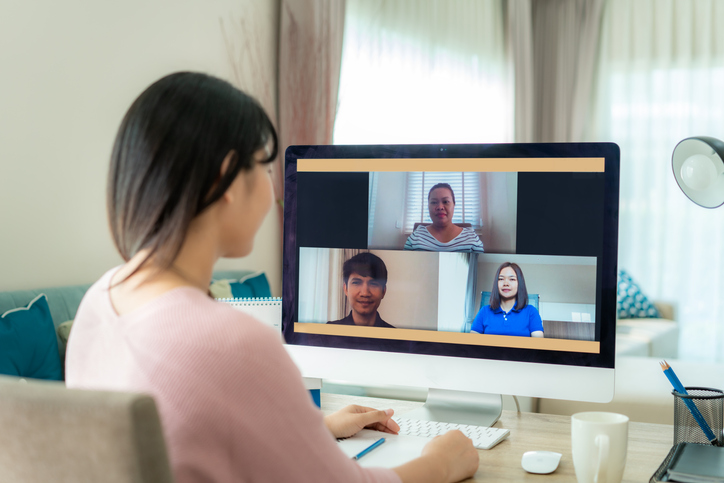Editor’s note: Gina Derickson is research director at market research firm Engagious, New York.
A year ago, I wrote a blog on some of the more effective approaches and tips I’ve employed to get the most out of the in-person focus groups and dial testing groups. That, of course, was before the COVID-19 pandemic. We now live and operate in a world where in-person research isn’t practical – at least for the time being.
As researchers, adapting to this new normal certainly presents its challenges. But I can attest, as someone who has conducted hundreds of online research studies, there are some silver linings to moving your research approach online. And right now, we can all use some silver linings.
Benefits and advantages
 First, in my experience, almost anything that you can do in an in-person focus group, you can do online. You may need to get comfortable with certain technologies or find a technology partner to help support your approach, but you can do it. Additionally, there are some unique benefits and advantages to online research that I have grown to really appreciate. Here are a few examples:
First, in my experience, almost anything that you can do in an in-person focus group, you can do online. You may need to get comfortable with certain technologies or find a technology partner to help support your approach, but you can do it. Additionally, there are some unique benefits and advantages to online research that I have grown to really appreciate. Here are a few examples:
- Recruiting. Recruiting for an online research study offers significantly more flexibility and possibilities – no geographic boundaries, for one. I’ve also found that participants who may have been hesitant to participate in an in-person focus group due to social anxiety, a medical condition or other concerns, can and do participate in online studies.
- No travel required. Removing all the X-factors involved in traveling to conduct research is a huge stress reliever for me and a definite benefit. No cancelled or delayed flights; no weather or traffic issues delay a session or cause poor show rates. The additional cost- and time-savings from not traveling sweetens the deal even more.
- Observing respondents’ natural environments. Seeing respondents in their own homes is one of the hidden gems of online research. When I chat with respondents via their webcams, I’m always looking for contextual clues that reveal a little more about each of them. Respondents tend to be more relaxed and comfortable in the homes, and breaks are less disruptive to the group (provided they turn their webcams off).
I also find the online focus group environment cuts down on side conversations and, if deemed necessary, I can remove a disruptive respondent with minimal interruption to the group.
Best practices
Similar to in-person focus groups, I’ve developed a list of best practices over time that have helped me maximize the effectiveness of online focus groups and overcome some of the challenges.
Keeping respondents engaged. Certainly, it’s a different type of challenge keeping respondents engaged online than when we’re in the same room. One thing I do to make sure my online respondents are engaged from the start is to include a proper introduction at the beginning. I go around the virtual room and encourage each respondent to introduce themselves and share something personal. I will usually kick it off myself to break the ice. I also set expectations in advance of the group session, making sure they understand that they are to treat this experience like a job; that they are receiving an incentive for being fully present and engaged for the entire session; and that they need to make sure that they are not disrupted by children, pets, etc., during the session.
Here is one tactic that works well for in-person sessions also works well online: I note any respondents who haven’t participated in the last few minutes and call on them first when I pose a new question to the group. After a while, they begin to realize they may get put on the spot if they don’t contribute, which is a pretty good motivator for those who don’t naturally like to speak up.
Technical limitations. A challenge of any online research can be the technical fluency and/or limitations of respondents. Bandwidth is always a consideration, and can be an issue for some respondents. I try to minimize any technical issues by conducting pre-session tech checks. I also ask respondents to log on early and I make sure to have a technical support person on standby to troubleshoot potential issues. Having a partner or a reliable tech service is worth the investment – they focus on making sure everything runs smoothly from a technical standpoint, which allows moderators to focus on moderating and getting the most out of the respondents.
Client engagement. Respondents aren’t the only ones you have to be sure to keep engaged throughout an online session. Moderators can do a few things to ensure clients are engaged. In many cases, an online focus group is a different experience than the traditional focus groups they are used to. Using a virtual backroom can help clients observe the group interactions and dial testing results together. It is also beneficial to have an easy-to-use platform that allows for real-time chats between client and moderator. I also plan a client-only, post-session debrief, typically using the same meeting platform I’ve used for the group session.
Yes, you can adapt
Yes, there are challenges to conducting your qualitative research online, but every type of research presents its own challenges. It’s important to remember that you do not have to fundamentally change your research approach when moving online. You need to adapt and give yourself time to get up-to-speed with the technology, but you can do it! If you’re still feeling your way through an online focus group approach, don’t hesitate to ask for help.
